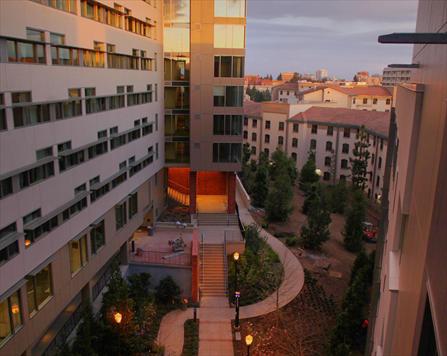The University of California, Los Angeles (UCLA) completed Holly Ridge and Gardenia Way, the newest buildings in the De Neve Plaza housing complex, capable of housing 800 students.
The construction of Holly Ridge and Gardenia Way finished several months ahead of schedule, allowing students to migrate to the new residence halls from the formally occupied Dykstra Hall in February.
Holly Ridge, also known as Upper De Neve, will house 496 students and Gardenia Way, also known as Lower De Neve, will house 307 students. Dykstra Hall will now undergo renovations to turn the 400-room building into a 10-story structure by 2013.
Holly Ridge and Gardenia Way are two of the four new resident hall additions to the UCLA campus as part of the Northwest Campus Student Housing In-Fill Project.
Upon completion, the Northwest Campus Student Housing In-Fill Project will add 500,000-sf of residential space including a 750-seat dining room, 1,525 bed spaces for single undergraduate students, student meeting rooms, and multi-purpose rooms that can accommodate up to 450 students. In total, the project will increase campus housing capacity from approximately 10,500 undergraduate students to approximately 12,000 in either new or renovated resident halls by fall 2013.
Gafcon Inc. and partner Benchmark Contractors are construction managers for the Northwest Infill project working alongside general contractor PCL Construction Services, Inc.
PCL Construction’s introduction of BIM for construction to the UCLA campus along with Gafcon’s SharePoint360 document storage services helped streamline project information for all partners and contributed to the early completion of the project. Architects for the project were Pfeiffer Partners Architects, Inc. and KieranTimberlake. BD+C
Related Stories
| Oct 5, 2011
GREENBUILD 2011: Brick offers growing options for sustainable building design
Brick exteriors, interiors and landscaping options can increase sustainability that also helps earn LEED certification.
| Oct 5, 2011
GREENBUILD 2011: Roof hatch designed for energy efficiency
The cover features a specially designed EPDM finger-type gasket that ensures a positive seal with the curb to reduce air permeability and ensure energy performance.
| Oct 4, 2011
GREENBUILD 2011
Click here for the latest news and products from Greenbuild 2011, Oct. 4-7, in Toronto.
| Oct 4, 2011
GREENBUILD 2011: Methods, impacts, and opportunities in the concrete building life cycle
Researchers at the Massachusetts Institute of Technology’s (MIT) Concrete Sustainability Hub conducted a life-cycle assessment (LCA) study to evaluate and improve the environmental impact and study how the “dual use” aspect of concrete.
| Oct 4, 2011
GREENBUILD 2011: Johnsonite features sustainable products
Products include rubber flooring tiles, treads, wall bases, and more.
| Oct 4, 2011
GREENBUILD 2011: Nearly seamless highly insulated glass curtain-wall system introduced
Low insulation value reflects value of entire curtain-wall system.
| Oct 4, 2011
GREENBUILD 2011: Ready-to-use wood primer unveiled
Maintains strong UV protection, clarity even with application of lighter, natural wood tones.
| Oct 4, 2011
GREENBUILD 2011: Two new recycled glass products announced
The two collections offer both larger and smaller particulates.
| Oct 4, 2011
GREENBUILD 2011: Mythic Paint launches two new paint products
A high performance paint, and a combination paint and primer now available.
















